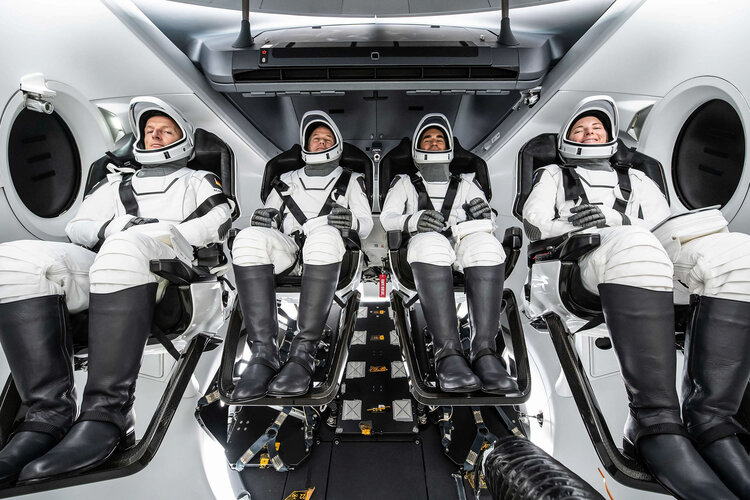NASA delays human lunar landing to at least 2025
Tuesday, 09 November 2021 21:21
NASA leadership has formally given up on the goal of returning humans to the moon by 2024, pushing back a landing by NASA astronauts on the lunar surface to at least 2025.
U.S. interagency panel to update R&D strategy to tackle orbital debris
Tuesday, 09 November 2021 20:54
The Biden administration plans to update an existing research-and-development plan aimed at combatting orbital debris.
Spaceflight to launch 13 payloads on first multi-orbit space tug mission
Tuesday, 09 November 2021 20:49
Launch services provider Spaceflight announced plans Nov. 9 to deliver 13 customer payloads across two distinct orbits for the first time next year with its new space tug.
NASA pushes back crewed Moon landing to 2025 or later: agency chief
Tuesday, 09 November 2021 19:47
The United States will send a crewed mission to the Moon "no earlier than 2025," NASA chief Bill Nelson told reporters on Tuesday.
A target of 2024 was set by the administration of former president Donald Trump when it launched the Artemis program, but it has faced numerous delays, including most recently litigation with Jeff Bezos' Blue Origin which unsuccessfully sued after losing a lander contract to SpaceX.
© 2021 AFP
Spaceports address environmental impact concerns
Tuesday, 09 November 2021 17:58Blockchain for Space: Cybersecurity, Supply Chain Management and Venture Financing
Tuesday, 09 November 2021 15:31
Blockchain is most often associated with Bitcoin, but the technology has important applications for many industries including the space sector.
Webinar – Blockchain for Space: Cybersecurity, Supply Chain Management and Venture Financing
Tuesday, 09 November 2021 15:31
Blockchain is most often associated with Bitcoin, but the technology has important applications for many industries including the space sector.
Major endorsement for new space mission to find 'Earth 2.0'
Tuesday, 09 November 2021 14:46
A major new space telescope searching for 'Earth 2.0'—to Succeed Hubble and the soon-to-be-launched James Webb Space Telescope (JWST)—is one step closer to reality.
The Large Ultraviolet Optical Infrared Surveyor (LUVOIR) is a leading mission concept to meet the recommendations of the long-awaited Astro2020 Decadal Survey, which identifies three 'priority scientific areas' for investment in astronomy and astrophysics in the U.S. over the next 10 years and beyond.
Martin Barstow, Professor of Astrophysics and Space Science at the University of Leicester, was appointed by the UK Space Agency as an external observer to the LUVOIR study team, and is co-author of the report backing the proposal. He is also chair of the Space Telescope Institute Council, which provides oversight to the body operates Hubble and will operate JWST.
Professor Barstow says that "Earth-like planets orbiting other stars are enormously difficult to find and detecting them is beyond the capabilities of our current planned space missions, but we are developing the technologies to carry out this search and are close to having the tools ready to fly in space.
Capella to install optical terminals on imaging satellites to share data with DoD space agency
Tuesday, 09 November 2021 14:39
Capella Space will begin installing optical communications terminals on synthetic-aperture radar (SAR) satellites in 2022 as part of a campaign to quickly deliver data to the Pentagon Space Development Agency’s new National Defense Space Architecture.
NASA tests beacon for safe recovery of astronauts on Artemis missions
Tuesday, 09 November 2021 13:01
NASA and the U.S. Navy are wrapping up the ninth in a series of tests at sea. They're verifying and validating procedures and hardware that will be used to recover the Orion spacecraft after it splashes down in the Pacific Ocean following deep space exploration missions.
Webb’s Ariane 5 core stage made ready
Tuesday, 09 November 2021 13:00 Image:
Webb’s Ariane 5 core stage was raised vertical in the launch vehicle integration building at Europe’s Spaceport in French Guiana
Image:
Webb’s Ariane 5 core stage was raised vertical in the launch vehicle integration building at Europe’s Spaceport in French Guiana Japan’s Epsilon 5 rocket launches nine small satellites
Tuesday, 09 November 2021 12:53
Japan’s solid-fuel Epsilon 5 rocket successfully put nine small satellites into orbit Nov. 9, including an orbital debris removal technology demonstrator.
Watch live: liftoff of Crew-3 to space
Tuesday, 09 November 2021 12:18
Tune in from Wednesday 10 November at 21:45 GMT/22:45 CET to see ESA astronaut Matthias Maurer be launched to the International Space Station for his first mission, Cosmic Kiss.
People with disabilities have been locked out of spaceflight, but that is changing
Tuesday, 09 November 2021 11:38
As the airplane tilted steeply upward, Mona Minkara experienced gravity like never before.
"It feels like a huge pressure is on you, and the skin of your face is being pulled over the bones of your skull," she says.
Virgin Galactic adds 100 customers after resuming ticket sales
Tuesday, 09 November 2021 11:21
Virgin Galactic executives said they’ve seen strong interest from customers as the company restarts sales of tickets on its suborbital vehicles, even though those customers may have an extended wait until they fly.

